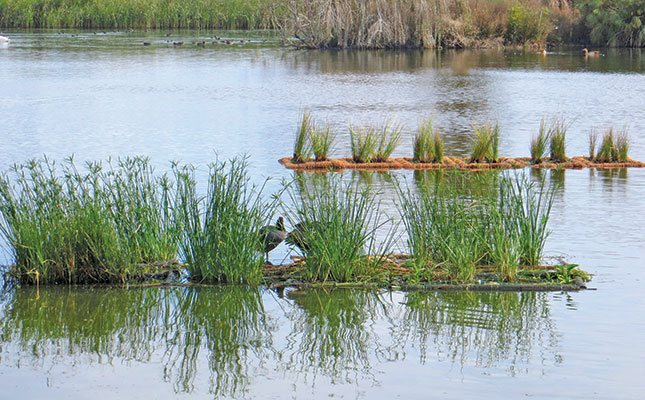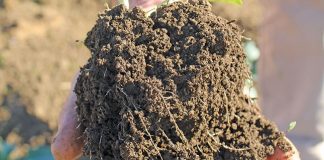
Photo: Sean Altern
The availability of usable fresh water is one of the main limiting factors to South African agriculture; the country experiences large annual and in-season variability in its supply of fresh water.
Farm dams are therefore an essential source of water for agricultural activities, as they bridge the gap between low- and high-flow periods by providing an efficient means for storing water.
Unfortunately, farm dams are prone to nutrient pollution, resulting in poor water quality. Increased nutrient levels lead to excessive algal growth, which can, in turn, result in the emission of harmful toxins. Furthermore, algal growth can cause major problems in farm dams by blocking irrigation systems.
This reduces the ability of these dams to provide safe, usable water for irrigation, as well as human and livestock consumption.
Enter floating wetlands
Floating wetlands are a budget-friendly and nature-based solution for improving water quality and increasing biodiversity. They comprise buoyant structures on which wetland plants are grown, and they use natural processes to remove nutrients and other agricultural chemicals from the water.
Plants require certain nutrients, especially nitrogen (N) and phosphorus (P), for growth. Under normal circumstances, they would obtain said nutrients from the soil through their roots.
In the case of floating wetlands, the stems and leaves of the plants grow above the water, and the roots below. Thus, since the plants aren’t growing in soil, the roots absorb the required nutrients directly from the water.
The many micro-organisms that live on the roots either assist the plants in absorbing nutrients, or absorb polluting nutrients themselves. This makes the wetlands more effective at treating polluted water than just the plants themselves.
Local wetland plants
Dr Alanna Rebelo, Prof Karen Esler, Olivia Brunings and Philip Frenzel, researchers in the Department of Conservation Ecology and Entomology at Stellenbosch University, tested the ability of these wetlands to treat nutrient-polluted farm dams.
They looked at three South African wetland plant species: the flat sedge (Cyperus textilis), palmiet (Prionium serratum) and leafy juncus (Juncus lomatophyllus).
The plants were grown on wetland structures in nutrient-polluted water for an experimental period of three months. During this time, water quality and the nutrient contents of dried plant material were tested monthly.
Flat sedge was found to have absorbed the most N and P out of the three species due to its fast and tall growth. It absorbed an average of 17mg N and 2,6mg P per plant daily. Palmiet and leafy juncus absorbed an average of 1,1mg to 6,3mg N, and 0,2mg to 0,5mg P per plant daily.
To understand in real terms what the impact of these uptake rates could mean for a farmer interested in using this solution on his or her farm dam, a quick calculation was done using the flat sedge results as an example.
If a farm dam had 10 floating wetlands, with 10 flat sedge plants on each, the potential uptake could be as much as 0,6kg N and 0,1kg P per year. On a small farm dam with a volume of around 30m³, these wetlands would greatly improve water quality.
It is important to choose the correct plant species so that the wetland system functions optimally in terms of nutrient removal. All three species used in the Stellenbosch University study are suitable, and possibly many other indigenous species, too.
If nutrients are to be removed from the system permanently, the plants need to be cut back every few months, which involves harvesting the above-structure material, which is then removed (see guide to making your own floating wetland structures on page 36). It is recommended that stems and leaves be trimmed and discarded just after the active summer growing season.
South Africa’s sunny climate allows for rapid plant growth, an important factor in facilitating the removal of nutrient pollution. Therefore, the country is suited to the use of floating wetlands to mitigate nutrient pollution in farm dams.
Floating wetlands can cope with changes in water levels, support biodiversity, and can even help to reduce water loss when compared with open water. Overall, these systems provide a safe, effective, and aesthetically pleasing way to combat nutrient pollution in South African farm dams.
How to build a floating wetland
Floating wetlands can easily be made by using low-cost materials. You will need:
- High-density buoyant foam;
- Plastic mesh;
- Hessian fabric;
- Wooden dowels; and
- Cable ties.
Step 1:

Decide on the size of your floating wetland, and cut your materials into the appropriate dimensions. The Stellenbosch University study built wetlands of 50cm x 40cm in size.
Step 2:

Using the high-density foam and wooden dowels, create rectangular structures. These will form the perimeters of the floating wetlands.
Step 3:

Using the cable ties, attach the hessian and plastic mesh to the rectangular floating structures. These will form the platforms on which the wetland plants will grow.
Step 4:

Position the wetland structures close to the farm dam on which they will be used, and place the chosen plants on the structures, together with a small amount of soil. With regular harvesting, a 50cm x 40cm floating wetland can support a maximum of approximately 10 plants.
Step 5:

The floating wetlands are now ready to be released onto the farm dam where they can get to work on absorbing nutrient pollution.
Visit ww.birdlife.org.za or www.waterpowermagazine.com.













